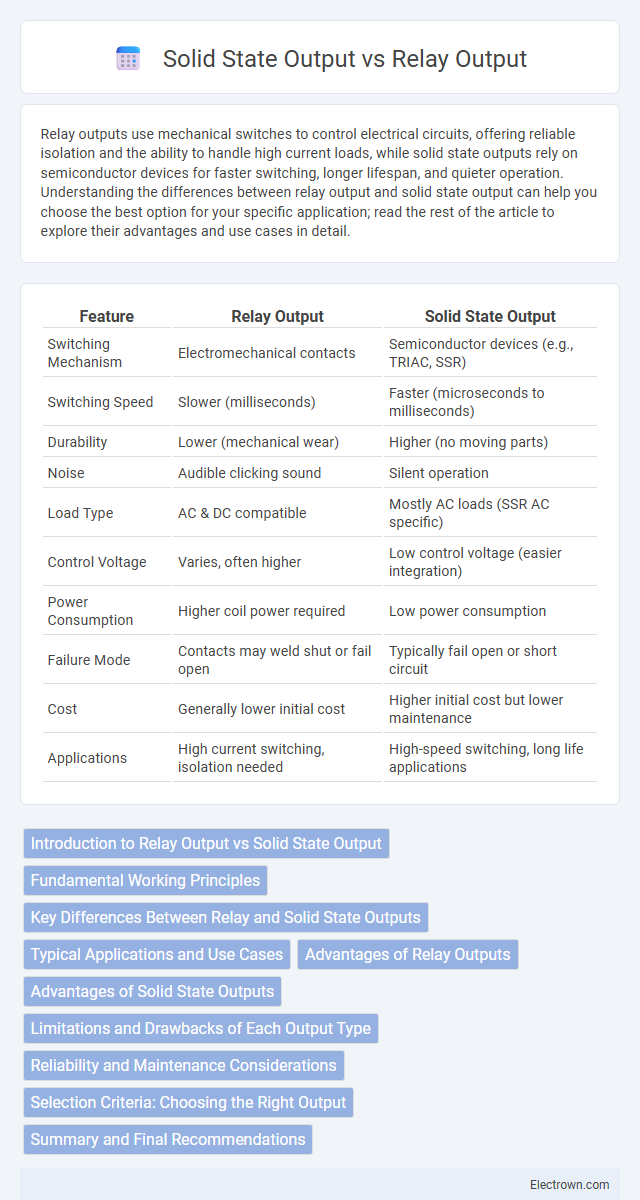Relay outputs use mechanical switches to control electrical circuits, offering reliable isolation and the ability to handle high current loads, while solid state outputs rely on semiconductor devices for faster switching, longer lifespan, and quieter operation. Understanding the differences between relay output and solid state output can help you choose the best option for your specific application; read the rest of the article to explore their advantages and use cases in detail.
Table of Comparison
| Feature | Relay Output | Solid State Output |
|---|---|---|
| Switching Mechanism | Electromechanical contacts | Semiconductor devices (e.g., TRIAC, SSR) |
| Switching Speed | Slower (milliseconds) | Faster (microseconds to milliseconds) |
| Durability | Lower (mechanical wear) | Higher (no moving parts) |
| Noise | Audible clicking sound | Silent operation |
| Load Type | AC & DC compatible | Mostly AC loads (SSR AC specific) |
| Control Voltage | Varies, often higher | Low control voltage (easier integration) |
| Power Consumption | Higher coil power required | Low power consumption |
| Failure Mode | Contacts may weld shut or fail open | Typically fail open or short circuit |
| Cost | Generally lower initial cost | Higher initial cost but lower maintenance |
| Applications | High current switching, isolation needed | High-speed switching, long life applications |
Introduction to Relay Output vs Solid State Output
Relay outputs provide mechanical switching by physically opening or closing contacts, offering high current capacity and excellent isolation for your control systems. Solid State Outputs (SSOs) use semiconductor devices to switch circuits without moving parts, ensuring faster response times, longer lifespan, and silent operation. Choosing between relay and solid state outputs depends on factors like switching speed, load type, durability, and the specific requirements of your application.
Fundamental Working Principles
Relay outputs operate by opening or closing physical contacts through an electromagnetic coil, enabling isolation between control and load circuits. Solid state outputs use semiconductor devices like transistors or thyristors to switch current without moving parts, providing faster response times and longer lifespan. Your choice depends on factors such as switching speed, electrical noise tolerance, and load type, as solid state outputs excel in high-speed applications while relays are better for high voltage or current isolation.
Key Differences Between Relay and Solid State Outputs
Relay outputs use electromagnetic switches to mechanically open or close circuits, providing physical isolation and the ability to handle high voltages and currents. Solid state outputs rely on semiconductor components such as transistors or thyristors, enabling faster switching speeds, longer lifespan, and silent operation without mechanical wear. Key differences include switching speed, durability, noise level, and voltage handling capabilities, with relays suited for high power applications and solid state outputs ideal for rapid, frequent switching scenarios.
Typical Applications and Use Cases
Relay outputs are commonly used in applications requiring electrical isolation and the ability to switch high voltage or high current loads, such as motor control, lighting systems, and HVAC equipment. Solid state outputs excel in scenarios demanding fast switching speeds, silent operation, and long service life, often found in automation systems, PLC outputs, and electronic device control. Both output types serve industrial and commercial environments but are selected based on load characteristics, switching frequency, and durability requirements.
Advantages of Relay Outputs
Relay outputs offer superior electrical isolation between control and load circuits, reducing interference and enhancing system safety. They can switch higher voltages and currents, making them suitable for heavy-duty applications and inductive loads. Your equipment benefits from their robust design, which provides reliable operation under varying conditions and protects sensitive electronics.
Advantages of Solid State Outputs
Solid state outputs offer faster switching speeds and longer operational lifespans compared to relay outputs due to the absence of mechanical parts. These outputs provide higher reliability under high-frequency switching conditions and reduced electrical noise, enhancing system performance. Solid state outputs also reduce maintenance requirements and improve resistance to shock and vibration, making them ideal for industrial automation applications.
Limitations and Drawbacks of Each Output Type
Relay outputs face mechanical wear and slower switching speeds, limiting their lifespan and performance in high-frequency applications. Solid state outputs suffer from heat dissipation issues and may experience leakage currents, affecting reliability and efficiency under heavy loads. Both output types require careful consideration of current ratings and environmental factors to avoid premature failure.
Reliability and Maintenance Considerations
Relay outputs provide high reliability in low-frequency switching applications but are prone to mechanical wear, leading to more frequent maintenance and potential contact degradation. Solid state outputs offer superior durability with no moving parts, resulting in longer service life and minimal maintenance requirements. Industrial environments demanding consistent operation without downtime often favor solid state outputs for their enhanced reliability and low upkeep.
Selection Criteria: Choosing the Right Output
Selecting the right output between relay and solid state depends on factors like switching speed, load type, and durability requirements. Relay outputs offer mechanical isolation and can handle higher surge currents, making them suitable for inductive loads and high-power applications. Solid state outputs provide faster switching times, longer operational life, and reduced electrical noise, ideal for applications requiring frequent switching and silent operation.
Summary and Final Recommendations
Relay output offers mechanical switching with electrical isolation, ideal for high current loads and applications requiring physical disconnection. Solid state output provides faster switching, longer lifespan, and silent operation, making it suitable for high-speed and low-maintenance environments. Choose relay outputs for robust, high-power switching needs and solid state outputs for efficiency and durability in your electronic systems.
relay output vs solid state output Infographic

 electrown.com
electrown.com